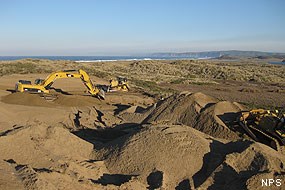|
abbotts lagoon coastal dune restoration project includes: Abbotts Lagoon Coastal Dune Restoration Project In mid-December 2009, the Seashore conducted a small pilot dune restoration project approximately 1 mile south of Abbotts Lagoon. The project lasted approximately one week and provided valuable information that is being used to refine the construction approach for this project, scheduled to begin implementation in February 2011. The pilot project involved mechanical removal of European beachgrass (Ammophila arenaria) through excavation and burial and placement of a clean sand cap that is not contaminated with the highly viable rhizome fragments. The project essentially represented a pilot or initial phase designed to refine construction approaches and cost estimates for the larger project currently in development. 
In past projects, mechanical removal of European beachgrass has typically focused on "horizon flipping" or excavation of the aboveground biomass and 3- to 6-feet of sands contaminated with rhizomes, with biomass and "dirty" sands being buried underneath a cap of clean sand varying anywhere from 3 to 6 feet deep depending on the potential mobility of the particular dune zone. However, mechanical excavation of anywhere from 100 to 120 acres is extremely costly. The Seashore has been working with its planning consultants to strategize on ways to improve and refine the mechanical excavation approach to decrease costs. Under the pilot project, potentially two or more mechanical approaches would be used—the horizon flipping method described above and a "bulldozer push" method. Under the latter method, contractors would use bulldozers to push the aboveground biomass and the top 3 feet of rhizome-contaminated "dirty" sands into existing, non-wetland swales in the backdunes (or dunes at the rear of the dune system). Biomass and "dirty" sands would be pushed into these topographic low points, and then "clean" sands below the excavated 3-foot "dirty" sand layer would be bulldozed over the top of the European beachgrass and iceplant materials to create a minimum 3-foot "clean" sand cap. The resulting excavation will reduce the exaggerated heights of the European beachgrass-stabilized backdune system, while maintaining the natural topographic low points between foredunes and backdunes, in dune swale wetland areas, and in blow-out or sparely vegetated dune "valleys" oriented approximately perpendicular to the shoreline. |
Last updated: May 27, 2024
